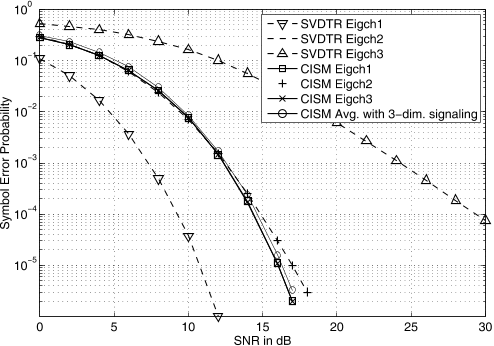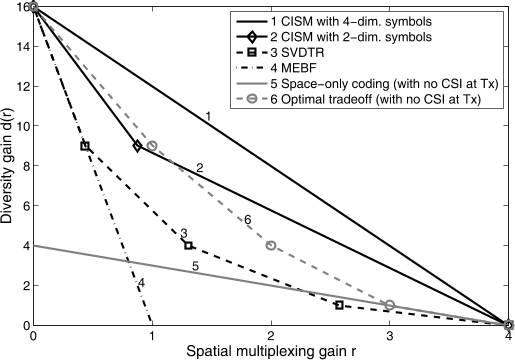




Did you find this useful? Give us your feedback










165 citations
...originally proposed for communications over single-antenna channel [14], [15] and MIMO channels [16]–[18], to achieve signal-space modulation diversity....
[...]
20 citations
...A similar result was reported in [15] with a technique employing the rotated Quadrature Amplitude Modulation (QAM) constellation....
[...]
18 citations
6 citations
...1, the CISM scheme introduced in [40] is an uncoded case of the proposed...
[...]
...In [40], the CISM scheme with SVD precoding is studied....
[...]
...We proved that the optimum spatial Q-component interleaver is exactly the interleaver proposed in [40] and consummate the theoretical analysis of [40]....
[...]
...As introduced in [13, 40, 45], for the M layer spatial multiplexing MIMO system, the precoding and detection process can be expressed as linear transformations z = Ū[M]HV̄[M]s+ Ū[M]n....
[...]
...In [40], the optimal rotation angle obtained by SEP analysis is only applicable to the uncoded CISM scheme with SVD precoding....
[...]
4 citations
[...]
23,986 citations
12,542 citations
8,084 citations
6,812 citations
...Multiple paths can be exploited to obtain diversity gain by transmitting the same symbol over all the paths, and multiple degrees of freedom can be used to increase the data rate through spatial multiplexing [3]....
[...]
6,469 citations
A diversity gain d(r) is achieved at a multiplexing gain r, if the data rate scales as R = r log SNR b/s/Hz and the SEP isPs(r log SNR) .= SNR−d(r) (4)where .= denotes exponential equality [2].
Let x ∈ CK×1, K ≤ n, be the symbol vector with xk ∈ Xk, 1 ≤ k ≤ K , where Xk is a unit energy QAM signal set employed on the kth eigen sub-channel, and E[xxH ] = IK .
To achieve an overall input data rate of R = r log SNR b/s/Hz, r ∈ [0, n], the authors choose two n-dimensional symbols (say, x1 and x2) carrying R/2 bits each.
Pr{xA → xB} ≈ κCABSNR−2m (12) where κ = 82mm 4 ( 4m−1 4m 4m−3 4m−2 · · · 12 ) andCAB = 1(cos2 θ)m+1(sin2 θ)m−1 + 1 (cos2 θ)m−1(sin2 θ)m+1− 2(m− 1) m 1 (cos2 θ sin2 θ)m (13)Similarly,Pr{xA → xC} ≈ κCADSNR−2m (14) whereCAD = 1ψm+11 ψ m−1 2+ 1ψm−11 ψ m+1 2−2(m− 1) m 1 (ψ1ψ2)m(15)Hence, at high SNRs,P 4-QAMs ≤ κ(2CAB + CAD)SNR−2m (16) θopt, the optimal rotation angle, is computed by maximizing the coding gain (2CAB + CAD).
Remark 2: The overall (classical) diversity gain of CISM with K ≤ n is given bygCISMd = ( m− ⌊ K + 12⌋ + 1 )( n− ⌊ K + 12⌋ + 1 ) (21)SVDTR, as well as many advanced diagonal transceivers such as those proposed in [8], have an overall diversity gain of gd = (m−K+1)(n−K+1) [10].
The diversity gain gd(k) of kth eigen subchannel has been determined in [10] asgd(k) = (m− k + 1)(n− k + 1), k = 1, . . . , n (3)and was also shown that gd(k) does not improve with spatial power allocation.
Remark 1 shows that, coordinate interleaving two data streams transmitted over two eigenmodes having different diversity gains would make the diversity gain of both the streams equal to the diversity gain of stronger eigenmode.
The UCD-VBLAST transceiver achieves the optimal open-loop tradeoff [9] and hence, the “Optimal tradeoff” curve also shows the DMT of UCDVBLAST.
Note that gd is the diversity gain for fixed input data rate (i.e., gd = d(0)), and to distiguish from d(r), it is referred to as classical diversity gain [14] wherever necessary.